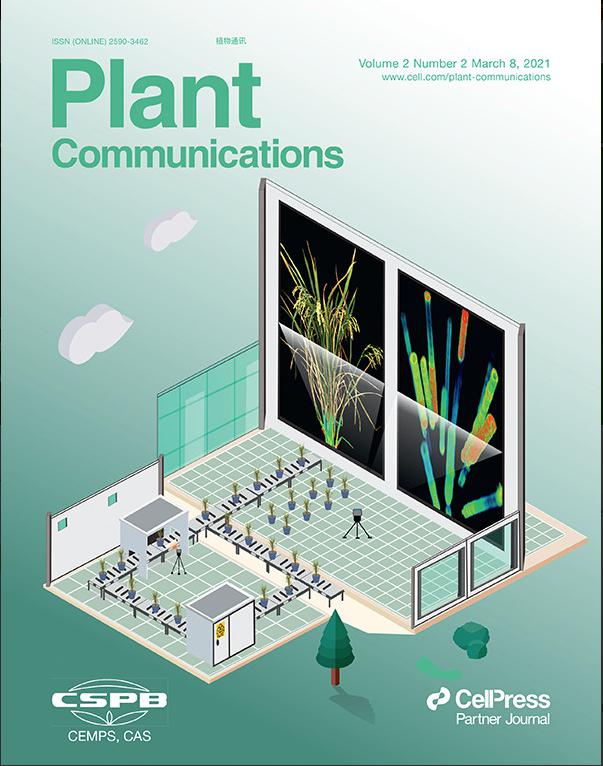
高通量微型CT水稻茎秆3D性状数字化分析新技术
南湖新闻网讯(通讯员 吴迪 吴丹硕)3月8日,我校作物遗传改良国家重点实验室作物表型团队题为A deep learning-integrated micro-CT image analysis pipeline for quantifying rice lodging resistance-related traits的研究论文以封面论文的形式刊发在Plant Communications。文章介绍了一种基于深度学习的高通量微型CT图像处理技术,实现了水稻茎秆3D性状和抗倒性状无损快速测定及精准分析,为未来水稻遗传改良提供了一种重要的水稻茎秆表型精准鉴定新技术和新方法。
有史以来,水稻是我国最主要的粮食作物之一,倒伏是影响水稻产量和收割效率的主要问题之一。同时,水稻株型结构是水稻驯化的关键因素,也是限制水稻高产的主要因素,理想的水稻茎秆结构是提高水稻抗倒伏能力的关键。然而,传统的水稻茎秆和抗倒表型性状测量方法具有破坏性、费时费力的特点,也无法提取和分析茎秆壁厚、茎秆面积、茎秆体积、分蘖角度等水稻茎秆内部3D性状。因此,急需一种高通量、精准的水稻茎秆和倒伏表型量化分析技术。
为了解决这一瓶颈,我校作物表型团队基于先期工作中自主研发的高通量作物CT扫描系统,开发了一种基于深度学习的微型CT水稻茎秆3D图像自动分析方法,提取茎秆3D性状包括长轴、短轴、壁厚、茎秆面积、分蘖角度、体积、表面积等24个表型性状。通过与人工测量数据比较,长轴、短轴和壁厚的R2值分别达到0.799、0.818和0.623,说明本技术具有较好的测量精度。且单株测量效率最高可达4.6分钟/株,为水稻抗倒伏数字化评估提供了一种高效和准确的新途径和新方法。

茎秆不同高度下抗倒性能分布3D热图(颜色越红表示抗倒性更好,颜色越蓝表示抗倒性更差)
更有趣的是,本技术可重建出水稻茎秆抗倒伏性3D可视化热图,反演茎秆不同高度下的抗倒性能分布,通过该3D热图可精准定位茎秆较为脆弱和可能倒伏的位置。
研究人员总结道,本文研发了一种基于深度学习和微型CT成像的水稻茎秆3D表型性状无损快速提取和分析的新技术和新方法,有潜力应用于未来水稻抗倒伏遗传育种等相关研究。且本技术可扩展应用于玉米、油菜、小麦、棉花等作物,具有良好的应用前景和市场推广前景。
据了解,我校作物表型团队一直致力于作物表型技术自主研发与应用,尤其在微型CT技术研发与农业应用上有一定的工作基础。已成功研发应用于水稻分蘖断层2D扫描和3D扫描的第一代X-CT,空间分辨率为0.5mm,主要应用于分蘖数测量及第二代微型X-CT,空间分辨率最高可达35微米,可提取更为精细的水稻分蘖大小,形态,分蘖角等性状,且相关核心技术专利已于2020年实现转化。本研究是作物表型团队在微型CT水稻表型技术研究上的又一次突破,且有望在未来实现技术转化。
该项研究成果获得国家重点研发计划、国家自然科学基金、中央高校基本科研专项资金资助。华中农业大学吴迪博士和吴丹硕士为本文的共同第一作者,华中农业大学杨万能教授为本文的通讯作者。
摘要
Lodging is acommon problem in rice, reducing its yield and mechanical harvestingefficiency. Rice architecture is a key aspect of its domestication and a majorfactor that limits its high productivity. The ideal rice culm structure,including major_axis_culm, minor axis_culm, and wall thickness_culm, iscritical for improving lodging resistance. However, the traditional method ofmeasuring rice culms is destructive, time consuming, and labor intensive. Inthis study, we used a high-throughput micro-CT-RGB imaging system and deeplearning (SegNet) to develop a high-throughput micro-CT image analysispipeline that can extract 24 rice culm morphological traits and lodgingresistance-related traits. When manual and automatic measurements werecompared at the mature stage, the mean absolute percentage errors formajor_axis_culm, minor_axis_culm, and wall_thickness_culm in 104indicarice accessionswere 6.03%, 5.60%, and 9.85%, respectively, andtheR2values were 0.799, 0.818, and 0.623. We also builtmodels of bending stress using culm traits at the mature and tillering stages,and theR2values were 0.722 and 0.544, respectively. Themodeling results indicated that this method can quantify lodging resistancenondestructively, even at an early growth stage. In addition, we also evaluatedthe relationships of bending stress to shoot dry weight, culm density, anddrought-related traits and found that plants with greater resistance tobending stress had slightly higher biomass, culm density, and culm area butpoorer drought resistance. In conclusion, we developed a deeplearning-integrated micro-CT image analysis pipeline to accurately quantify thephenotypic traits of rice culms in ∼4.6 min perplant; this pipeline will assist in future high-throughput screening of largerice populations for lodging resistance.
原文链接:https://www.cell.com/plant-communications/fulltext/S2590-3462(21)00040-7

